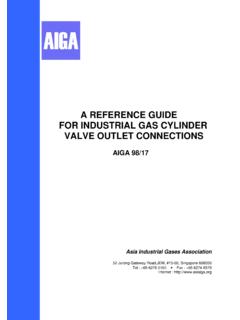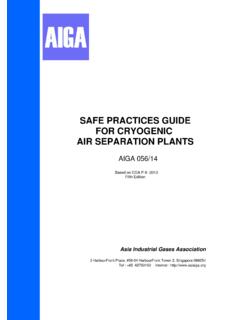Transcription of OXYGEN PIPELINE AND PIPING SYSTEMS - ASIA INDUSTRIAL …
1 OXYGEN PIPELINE AND PIPING . SYSTEMS . AIGA 021/12. GLOBALLY HARMONISED DOCUMENT. Replaces AIGA 021/05. asia INDUSTRIAL Gases Association 3 HarbourFront Place, #09-04 HarbourFront Tower 2, Singapore 099254. Tel : +65 62760160 Fax : +65 62749379. Internet : AIGA 021/12. GLOBALLY HARMONISED DOCUMENT. OXYGEN PIPELINE . AND PIPING SYSTEMS . Disclaimer All technical publications of AIGA or under AIGA's name, including Codes of practice, Safety procedures and any other technical information contained in such publications were obtained from sources believed to be reliable and are based on technical information and experience currently available from members of AIGA and others at the date of their issuance.
2 While AIGA recommends reference to or use of its publications by its members, such reference to or use of AIGA's publications by its members or third parties are purely voluntary and not binding. Therefore, AIGA or its members make no guarantee of the results and assume no liability or responsibility in connection with the reference to or use of information or suggestions contained in AIGA's publications. AIGA has no control whatsoever as regards, performance or non performance, misinterpretation, proper or improper use of any information or suggestions contained in AIGA's publications by any person or entity (including AIGA members) and AIGA expressly disclaims any liability in connection thereto.
3 AIGA's publications are subject to periodic review and users are cautioned to obtain the latest edition. NOTE Technical changes from the previous edition are underlined. Reproduced with permission from European INDUSTRIAL Gases Association. All rights reserved. asia INDUSTRIAL GASES ASSOCIATION. 3 HarbourFront Place, #09-04 HarbourFront Tower 2, Singapore 099254. Tel: +65 62760160 Fax: +65 62749379. Internet: AIGA 021/12. Table of Contents 1 Introduction .. 1 2 Scope and 1 3 2 4 Design 4 General criteria .. 4 Materials compatibility for OXYGEN 6 Selection of metals .. 7 Velocity exemption pressures for standard purity OXYGEN .. 8 Reduced purity OXYGEN -enriched 8 Ultra high purity (UHP) OXYGEN 9 Temperature 9 Velocity and gas pressure criteria.
4 10 Selection of 12 Properties and 12 PIPING 14 Siting, remote operation, use of barriers .. 15 5 PIPING , valves, and equipment .. 16 General criteria .. 16 Material selection 16 PIPING and fittings .. 16 Impingement sites .. 16 Non-impingement 17 Specific PIPING locations .. 17 Valves .. 18 18 Valve functions ..19 Valve types .. 21 Valve seals and 22 Other possible sources of ignition in valves .. 22 22 Conical Y-strainers .. 23 23 Flow-measuring 24 Bursting disks .. 25 Insulating 25 Flexible 26 Miscellaneous equipment items .. 26 Protection SYSTEMS .. 27 Heat exchangers .. 27 Lubricants .. 27 6 Cleaning .. 28 General 28 Cleaning strategy .. 28 Standard of cleanliness.
5 28 Cleaning methods .. 28 PIPING system components .. 29 29 Pressure Installation of PIPING 29 Specification and manufacture of line pipe 30 General 30 Codes and standards .. 30 Manufacturing process .. 30 Heat Hydrostatic 30 AIGA 021/12. Pre-cleaned 30 30 Pipe 31 Pressure Internal surface finish .. 31 Preparation for shipment .. 31 Maintaining cleanliness .. 31 Final cleaning .. 32 Leak testing and 32 Post-installation 33 33 Pressure Internal surface finish .. 33 Maintaining cleanliness .. 33 Leak testing and 33 Inspection .. 33 Procedure .. 33 UVA light examination .. 34 Acceptance 34 Remedial 34 Sealing, purging, and 34 Records .. 34 7 34 General criteria.
6 34 Construction 35 Pipe fabrication and 35 Qualifications .. 36 Backing rings .. 36 Preparation for welding .. 36 Welding requirements for 36 Assembly and installation .. 36 36 Flanged joints .. 37 Insulating 37 Threaded 38 Supports, guides, and 38 Inspection and 38 Non-destructive 39 Pressure X-ray examination .. 39 40 8 Design and construction of control stations .. 40 Function .. 40 Design 40 Emergency shut-off valves .. 40 Isolation valves .. 41 Throttling and process control 41 Filters and 41 Flowmeters .. 41 Flow and pressure control .. 42 Gas storage .. 42 Spill or vent Pressure relief and vent valves .. 42 42 Standards and design codes.
7 42 Materials .. 43 AIGA 021/12. Barriers or screens .. 43 Barrier requirements 43 Design 43 Operational 44 Location .. 44 Earthing, grounding .. 45 Fabrication .. 45 46 Testing .. 46 Post 46 Post installation .. 46 Commissioning .. 46 Safety .. 46 Procedure .. 46 47 Operation .. 47 9 Operation, monitoring, and 47 General safety 47 Personnel for operation and maintenance .. 48 Operating isolation valves .. 48 Welding and cutting work .. 48 OXYGEN enrichment and deficiency .. 48 Shutdown/startup of pipelines and PIPING SYSTEMS .. 49 Venting and pressure relief .. 49 Purging .. 50 50 Commissioning pipelines, PIPING , and 50 Operation and monitoring.
8 50 Information to third parties, work adjacent to pipelines, and update of documents .. 51 51 Flow of information .. 51 Summary of work .. 51 Records .. 51 Updating of PIPELINE drawings .. 51 Specialized surveys .. 51 Damage to the PIPELINE system .. 52 52 52 10 General protective measures .. 52 Emergency response 52 Liaison with public authorities and other consultees .. 52 Description of PIPELINE 52 Control centers ..52 Notification of an incident .. 53 Alerting procedure .. 53 Shutting down a PIPELINE .. 53 Emergency equipment .. 53 Remedial 53 Pipelines with cathodic protection .. 53 Incident report 53 Emergency exercises .. 53 Power supplies and lightning strikes.
9 53 54 OXYGEN deprivation hazards and precautions .. 55 Accident and damage report .. 55 Safety management system .. 55 Notification to authorities and consultation on routing .. 55 Design and 55 AIGA 021/12. Shut-down SYSTEMS .. 55 Operations .. 55 Control of third party 56 Maintenance and 56 Major accident prevention policies and safety management SYSTEMS .. 56 Emergency 56 Information to the public and interested parties .. 57 Land use planning .. 57 Accident 57 11 57 12 Additional references .. 60 Appendix A Description of promoted ignition combustion test method (Informative) .. 66 Appendix B Potential Ignition Mechanisms (Informative).. 68 Appendix C Table of nominal alloy compositions and ranges (Normative).
10 69 Appendix D Table of exemption pressures and minimum thicknesses (Normative).. 70 Appendix E Table of minimum safety distances (without barriers) for OXYGEN control and isolating/metering stations (Informative) .. 71 Appendix F Example of preventive maintenance program (Normative).. 72 AIGA 021/12. 1 Introduction This publication has been prepared by a group of specialists in OXYGEN PIPING and PIPELINE SYSTEMS , representing major OXYGEN producers in various countries of Europe and North America and is based on the technical information and experience currently available to the authors. The INDUSTRIAL gases companies have engaged, through the International Harmonisation Council (IHC), comprised of the asia INDUSTRIAL Gases Association (AIGA), Compressed Gas Association (CGA) and the European INDUSTRIAL Gases Association (EIGA), Japan INDUSTRIAL and Medical Gases Association (JIMGA) in a process of developing harmonized safety practices and this publication is one of them.














